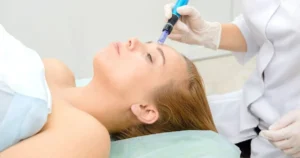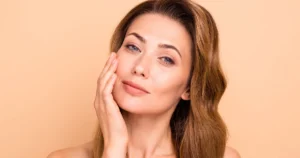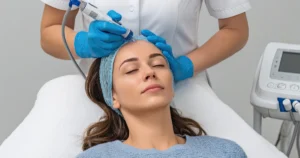Exploring skincare treatments is like traversing a complex labyrinth, where dermaplaning and microdermabrasion stand out as two renowned choices. Each of these treatments provides distinct advantages and addresses specific skin requirements. If you’re undecided between the two, rest assured that we’ll provide clear insights into both, helping you make a well-informed decision for your skin’s health.
Understanding Dermaplaning
Dermaplaning is a physical exfoliation procedure that involves the use of a sterile surgical scalpel. The primary goal is to scrape off the dead skin cells’ top layer along with fine vellus hair (commonly known as ‘peach fuzz’). This treatment leaves your skin smoother and brighter, and it enhances the effectiveness of skincare products by allowing deeper penetration.
Ideal Candidates for Dermaplaning
Here are some key characteristics of ideal candidates:
- People Seeking Smoother Skin Texture and Radiance
- Those with Dry or Slightly Dull Skin
- Individuals Looking for Non-Chemical Exfoliation
- People with Fine Facial Hair (Peach Fuzz)
- Individuals Not Prone to Acne Breakouts
- Those Seeking Immediate Results with No Downtime
Consult a skincare professional or dermatologist before dermaplaning, especially for specific skin concerns, to assess your skin type and determine the best treatment option.
Benefits of Dermaplaning
Dermaplaning offers a range of benefits, making it a popular choice for many seeking a non-invasive skincare treatment. Here are some of the key benefits:
- Smoother Skin Texture: Dermaplaning removes the top layer of dead skin for a smoother, more radiant complexion.
- Enhanced Product Absorption: It improves the absorption of skincare products by removing dead skin and fine hairs.
- Reduction of Fine Lines: Dermaplaning minimizes fine lines, offering a youthful skin appearance.
- Brighter Skin Tone: This procedure evens out skin tone by removing outer skin layers, including pigmented cells.
- Removal of Peach Fuzz: Dermaplaning effectively removes fine facial hair, enhancing skin cleanliness and smoothness.
- Suitable for Most Skin Types: Safe for all skin types, it’s especially beneficial for those sensitive to chemical exfoliation.
- No Downtime Required: Dermaplaning allows immediate return to normal activities with no significant downtime.
- Enhanced Makeup Application: Smoother skin post-dermaplaning enables smoother and more even makeup application.
Most importantly, dermaplaning requires a qualified professional for safety and effectiveness, and individual results may vary. Consult a skincare specialist or dermatologist for specific skin concerns.
Considerations
When considering dermaplaning, it’s important to weigh various factors to determine if it’s the right choice for your skincare needs. Here are some key considerations:
- Skin Type and Conditions: Dermaplaning is suitable for most but not recommended for those with active acne or highly sensitive skin.
- Risk of Minor Irritation: Gentle dermaplaning may cause temporary minor redness or skin irritation.
- Professional Execution: Trained professionals should perform dermaplaning to avoid potential skin damage.
- Maintenance and Frequency: Regular 3-4 week sessions are required to maintain the results of dermaplaning.
- Sun Sensitivity: Increased sun sensitivity after dermaplaning necessitates the use of high-SPF sunscreen.
- Cost and Accessibility: Consider the cost and local availability of dermaplaning in your skincare budget.
- Expectations: While effective for exfoliation and hair removal, dermaplaning is less suitable for treating deep wrinkles or acne scars.
- Combination with Other Treatments: Dermaplaning’s effects can be enhanced when combined with other treatments like facials or chemical peels.
By taking these considerations into account, you can make a more informed decision about whether dermaplaning is suitable for you. Always seek the opinion of a dermatologist or skincare specialist based on your skin type and issues.
Exploring Microdermabrasion
By using a spray of microcrystals, microdermabrasion, on the other hand, is a non-invasive, non-chemical method that gets rid of the topmost layer of dry, dead skin cells, revealing a younger, healthier-looking skin. It’s particularly beneficial for those wanting to address issues like fine lines, wrinkles, sun damage, and light scarring.
Ideal Candidates for Microdermabrasion
The ideal candidates for microdermabrasion typically include:
- Individuals with Uneven Pigmentation, Dull Skin, or Age Spots
- People with Fine Lines and Wrinkles
- Those with Acne Scars or Pitted Skin
- Individuals with Oily Skin and Enlarged Pores
- People Seeking a Non-Invasive Procedure
- Those with Congested Skin or Comedones
- Individuals Looking for Regular Skin Maintenance
- People with Thickened Skin Texture
However, microdermabrasion may not be suitable for individuals with severe acne, sensitive skin, or rosacea, so seek a dermatologist or skincare professional before using this treatment.
Benefits of Microdermabrasion
Microdermabrasion, a popular non-invasive skin treatment, offers many benefits for various skin types and concerns. Here are some of the key advantages of this procedure:
- Improves Skin Texture and Tone: Microdermabrasion exfoliates the top skin layer for a smoother texture and more even tone.
- Diminishes the Formation of Wrinkles and Fine Lines: It reduces aging signs like wrinkles and fine lines by removing dead skin and stimulating renewal.
- Helps with Acne Scars and Pitting: Regular sessions reduce the depth of acne scars and pitting through new cell growth.
- Unclogs Pores and Reduces Their Appearance: This procedure cleanses and reduces the size of pores, particularly for oily skin and those with blackheads.
- Enhances Product Absorption: Microdermabrasion enhances skincare product absorption by removing dead skin layers.
- Stimulates Blood Flow and Collagen Production: The treatment boosts blood flow and collagen, improving skin nutrition and resilience.
- Treats Hyperpigmentation and Sun Damage: It’s effective in lightening dark spots and reducing sun damage for a uniform complexion.
- No Downtime Required: Microdermabrasion offers immediate return to activities without downtime.
- Safe for Most Skin Types: Suitable for various skin types and colors, it’s a versatile skincare choice.
- Immediate Results with Progressive Improvement: Provides immediate brightening and smoothing, with further improvements after more treatments.
It’s essential to get microdermabrasion done by a qualified professional and discuss any skin concerns or conditions beforehand. While microdermabrasion offers numerous benefits, but it may not suit everyone, especially those with certain skin conditions or sensitivities.
Considerations
When considering microdermabrasion as a skincare treatment, there are several important factors to take into account to ensure it’s the right choice for your skin:
- Skin Type and Sensitivity: Microdermabrasion is generally safe but may irritate those with very sensitive skin, severe acne, eczema, dermatitis, or rosacea.
- Risk of Irritation and Redness: Temporary redness, dryness, or minor swelling may occur post-treatment, usually subsiding within a day.
- Sun Exposure: Post-treatment skin is more sun-sensitive, requiring minimized sun exposure and high-SPF sunscreen for protection.
- Expectations: Microdermabrasion effectively improves superficial skin issues and texture but may not significantly alter deep wrinkles or deep acne scars.
- Frequency and Number of Sessions: Optimal results often need multiple sessions, not permanently resolving skin issues, spaced several weeks apart.
- Professional Procedure: A qualified professional should perform microdermabrasion to avoid incorrect technique and potential skin damage.
- Pre-existing Skin Conditions: Existing conditions like active acne, open wounds, or skin infections could worsen with microdermabrasion.
- Maintenance: Post-treatment care includes hydration, avoiding harsh skincare products, and following professional instructions.
- Cost and Accessibility: Factor in the treatment’s cost and availability, as multiple sessions may be necessary.
- Complementary Treatments: Microdermabrasion can be combined with other treatments like facials or chemical peels for enhanced results.
By carefully considering these factors and consulting with a skincare professional, you can make an informed decision about whether microdermabrasion is the right choice for your skin needs and goals.
Making Your Choice: Factors to Consider
Making the right choice between dermaplaning and microdermabrasion for your skincare needs involves careful consideration of several factors. Here’s a guide to help you in your decision-making process:
Assess Your Skin Type and Concerns:
- If you have sensitive or dry skin, or if you’re primarily interested in removing fine facial hair and achieving a quick refresh, dermaplaning may be more suitable.
- If you have concerns like acne scars, sun damage, or oily skin, and are looking for a more intensive exfoliation, microdermabrasion might be the better option.
Understand the Desired Outcomes:
- For immediate brightening and smoothness with minimal risk, dermaplaning is effective.
- For longer-term results in skin texture and appearance improvement, especially with issues like hyperpigmentation and fine lines, consider microdermabrasion.
Consider the Level of Invasiveness and Downtime:
- Dermaplaning is less invasive with no downtime, ideal for those who want a gentler approach.
- Microdermabrasion might require a short recovery period, especially if your skin is sensitive.
Consult a Professional:
- The most crucial step is to consult with a dermatologist or skincare specialist. They are able to provide tailored guidance according to your particular skin type and problems.
Think About Maintenance and Frequency:
- Dermaplaning might require more frequent sessions for maintained results.
- Microdermabrasion results can last longer, but it may also require a series of treatments.
Budget and Accessibility:
- Consider the cost and availability of these treatments in your area, as well as the potential need for multiple sessions.
Evaluate Your Lifestyle and Preferences:
- Think about your daily routine, skincare habits, and how either treatment would fit into your lifestyle.
Trial and Error:
- Sometimes, the best way to decide is through experience. You might want to try both treatments (at different times) to see which works best for your skin.
By taking these factors into account and seeking professional advice, you can make a well-informed choice that aligns with your skin’s needs and your personal preferences. Remember, skincare is highly individual, and what works for one person may not work for another.
Final Thoughts
Both dermaplaning and microdermabrasion offer pathways to revitalized skin, and your choice should align with your skin type, concerns, and the goals you wish to achieve. At Noble Clinic Medical Aesthetics, we proudly offer Dermaplaning, an advanced cosmetic exfoliation technique utilizing a sterilized scalpel to eliminate both peach fuzz and dead skin cells, revealing a smooth, rejuvenated, and radiantly refreshed complexion. Experience the rejuvenating power of Dermaplaning, where every precise stroke reveals a smoother, more radiant complexion, setting the stage for lasting skin revitalization.





